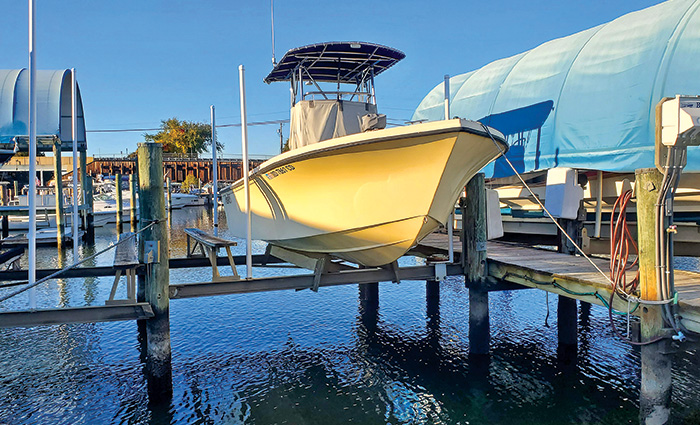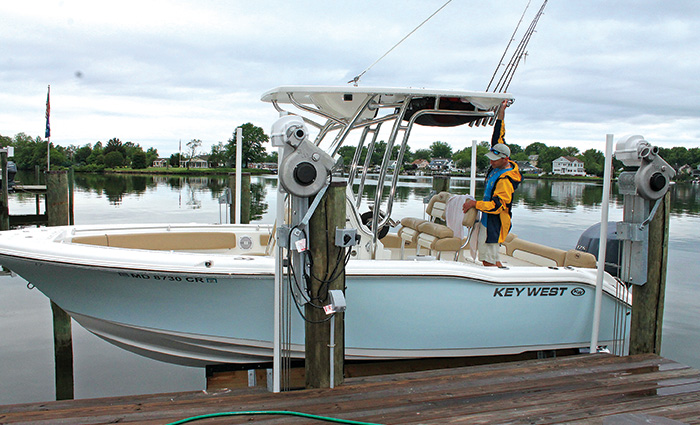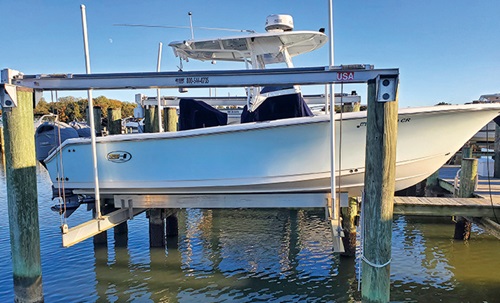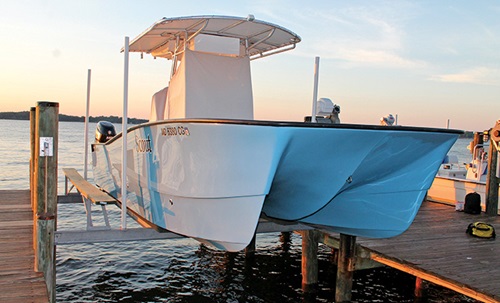Advertisement
Keeping Your Boat On A Lift Has Numerous Advantages. But Getting It On And Off The Lift Can Be Intimidating For Skippers Accustomed To Wet Slips

Bow- or stern lines (or both) can be kept on the boat to keep it in place once the lift is lowered, as long as there’s enough slack for the lift to travel up and down without tensioning the line(s).
Keeping your pride and joy high and dry on a boat lift beats tying up Mom’s Mink in a wet slip by a mile. Lift-kept boats seldom sink where they sit, and for every boat that sinks while underway, four go down in their own slips. On top of that, boats on lifts never need bottom paint, don’t take on those unsightly waterline marks, and don’t bounce around then potentially break a line or whack a piling when gale-force winds are gusting. Plus, when it’s time to use the boat, you can adjust its height for easy loading.
There’s just one problem: To use your boat, you’ll have to learn how to get it onto and off the lift. Operating the lift itself is as easy as flipping switches or pushing buttons, and today there are plenty of lifts you can even operate with an app or a remote control. But then what?
Preparing The Lift
There’s some prep work you need to do before using the lift. Most important is first ensuring the guides and bunks are sized and adjusted to fit your boat, which is a job best left to the marina or a professional who’s bonded and insured. The rest is up to you, starting with finding the ideal orientation for your boat and flagging it with a visual cue. You’ll probably want it centered or slightly forward of center over the bunks, depending on the weight and location of your power plant(s), to evenly distribute the weight fore and aft. To find the perfect spot, you’ll need to move the boat around manually over the submerged bunks. When the boat is centered, look for a piece of immobile hardware (like a cleat, fuel-fill, or flush-mounted fishing rod holder) that’s lined up with a piling, lift post, or other immobile item on the lift or pier. These will be the marks you line up.
If you boat in tidal waters or a body of water with fluctuating water levels, you’ll need to mark the lift’s minimum submersion level for loading and unloading, considering water level. With the bunks lowered enough and the boat in position over the bunks at low water, raise the lift until the bunks are supporting the boat’s weight, then lower it in increments of an inch or two at a time. When the boat floats freely, mark the lift’s waterline. The best way to mark it depends on the parts of the lift that are exposed and the types of materials (with PVC pipes, all you need is a permanent marker or a ring of electrical tape), or you may also be able to spot an existing visual cue such as an affixed support or joint that sits at just the right height. You may need to take other steps to assure that the lift and boat are ideally situated.
Tips For Storing a Boat On A Lift
- Keeping your boat on a lift is NOT a good idea in a hurricane. You can tie your boat to the lift and dock to combat flood tides, but our BoatU.S. Catastrophe Team has seen boats overcome by storm surge, blown off lifts, and boats that were overwhelmed with rainwater until the lift collapsed.
- You can leave permanent bow lines or stern lines (or both) on the boat to keep it in place once the lift is lowered, as long as there’s enough slack in the lines for the lift to travel fully up and down without tensioning them.
- If your boat has a pressurized livewell, drain it completely prior to raising the lift. Otherwise, the vacuum created by water that can’t drain out will hold the hatch down with immense suction.
- The bow of the boat should always be raised slightly higher than the stern to allow for rainwater draining.
- Outboards and sterndrives should be left in the tilted-down position. This is especially important in colder climates where a lower unit left in the up position may collect rainwater, leading to freeze-damage.
- When a lift isn’t in use, leave it in the up position to minimize corrosion and marine growth.
- For safety, keep people on the dock, not in the boat, while the lift is in operation.
- Remember to put in drain plugs before lowering the boat, and be sure to remove them before storage after lifting.
- Some boats, particularly larger ones, may need a bilge pump for heavy rain events, even while the boat is on the lift.
- Be careful around potential dangers such as the lift cable and worm gears. — L.R.

Being able to adjust the boat’s height makes loading and unloading much easier.
Putting Your Boat On The Lift
If the water rises and falls where you’re located, when you make your initial approach, look for that waterline mark to be sure the lift is at the proper height. If it’s lower than ideal it isn’t a problem; but if it’s higher than expected, you’ll need to lower the lift, even if the bunks themselves are beneath the surface, because they may not be deep enough to allow the hull to pass overtop when positioning the boat. In some cases, you may need to nose the boat up to the dock and drop someone off so they can lower it.
With the boat lined up along the center, slowly move forward until the bow is nearing the bunks, then shift into neutral and let momentum carry it the rest of the way forward. Don’t worry about being a little off and bumping a guidepost – that’s what they’re there for and why they’re cushioned or made from flexible material that won’t damage the boat. If you find your angle is wrong to get into the slip, simply back out and approach again.
Grab the dock and guide the boat forward until it’s in position, but pay close attention so you don’t move it very far past your predetermined mark. Many lifts have a cross-brace that your outdrive may hit if you go too far forward. Once the boat is properly positioned, turn off the engine.
The next part can get a little tricky on some lifts. It’s time to turn the lift on, but as the lift runs up you need to be sure the weight in the boat is more or less centered so the boat doesn’t list or isn’t otherwise askew as the bunks meet the hull. If so, the boat may rest on them at an angle and it won’t be level.
It may be easiest and safest to step onto the dock and position the boat from the dock with one or more boat hooks and lines. Passengers, significant loads, and you should be removed from the boat before you begin the lifting procedure. Lines (even stainless cables) supporting timbers, bunks, lift motors and any number of other things can break, leaving you and passengers to tumble into the water, perhaps with serious injury.
Most lifts are not to be used as elevators for people and will have a warning advising against this. Even if you don’t see one, assume it was probably there and wore off. If the boat isn’t level as it rises out of the water, lower the lift, redistribute weight as necessary, and try again.

The boat may need to be slightly forward of center on the bunks to account for engine weight; ideally it’s the weight, not the hull length, that will be centered.

You can use a part of the lift as a mark for the minimum submersion level. In this case, the owner found that when the side access board (see arrow) is lowered to the water level, the boat will float freely.
Taking Your Boat Off The Lift
Getting your boat off the lift for a day of boating is simple: Just lower the lift until it reaches your submersion mark and the boat is floating freely, and turn off the lift. Be sure to have the boat’s line or lines secured. Then climb aboard, start your engine, make sure the steering is centered, and back straight out of the slip after untying. And always be 100% sure to turn the lift off, or significant damage may result. It’s usually much better to load the boat in the water as it will be better balanced, more stable, and less likely to fall.
Wait a sec – marina lift slips can cost twice as much as a wet slip, and purchasing a lift for your own dock costs an arm and a leg. Is it really worth that extra expense? That’s a judgment call every boat owner has to make for themselves, but we know what Mom’s Mink would say.
